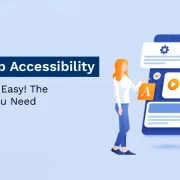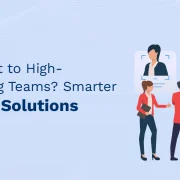
10 Best Practices in Blended Learning
Blended learning refers to the use of more than one delivery method to provide enhanced learning. Originally, blended learning referred to the addition of an online segment to the traditional classroom courses. However, the evolution of technology has ensured a more or less equal share between online and offline methods. No matter which component weighs more than the other, the fact remains that blended learning uses more than one approach to learning to ensure better learning outcomes.
Related: Advantages of Blended Learning over Traditional eLearning Methods
Here are some advantages of following a blended learning strategy.
- Multi-Platform Learning: Learners are no longer restricted to a single delivery channel to meet their learning needs. For example, in a traditional classroom setting, an instructor teaches an entire class comprising of students with diverse capabilities, attention spans, and levels of interest, which means that not all learners get a level playing field. A blended approach allows learners to go beyond a single delivery platform to other mediums to plug their gaps in learning. For the more intelligent ones, it opens up new avenues to further build on their skillsets.
- Promotes a Continuous Learning Approach: Since learners have access to multiple avenues for learning, they can leverage the best of both worlds to upgrade their skills and knowledge. Thus, blended learning promotes a continuous learning approach, which is more effective at creating a deeper understanding.
- Provides Opportunities for Social Learning and Collaboration: Learners can interact with their instructor and peers in a classroom setting; besides, they can also extend the collaboration to a global community on online forums and social media for a more enriched experience.
- Reach a Geographically Dispersed Audience: As companies go global, there is a need to take training beyond traditional classroom settings. Technology-enabled delivery can reach a geographically dispersed audience, thus providing savings in terms of time and cost.
- Access Ready References: A combination of online learning and classroom learning can also help to save time, which is a precious resource in enterprises with employees already straddling a host of job responsibilities. In blended learning, instructors can share online materials that provide a context of the concepts to be taught in classrooms, which the learners can access and prepare before coming to the class. This not only saves instructor and classroom time but also ensures that all learners are on the same page and are ready to move on to the next during the offline training session.
Related: Is Blended Learning the Right Approach for Your Enterprise?
Here are Top 10 Blended Learning Best Practices:Designing lessons for blended learning takes on a different approach from designing a stand-alone course. Here are ten best practices for blended learning.
- Design Your Course to Meet Specific Learning Outcomes:While designing your blended learning courses, keep in mind to focus on your learning objectives and not the latest technology.
- A Judicious Mix of Technology and the Human Element:While the millennial generation is more tech-savvy, the older generation is seen to be more comfortable with the traditional settings. While designing your blended learning courses, it is a good idea to conduct a survey to understand what delivery methods your employees are most comfortable with. Remember, technology cannot replace the warmth, comfort and security of a human interaction. Ensure that there is a judicious mix of both to retain the learners’ interest and ensure deep learning outcomes.
- Consider Use Cases: Apart from taking learners’preference into account, also take into account previous use cases to understand what blended delivery methods meet your employees’ learning needs. For example, you may require training courses for your sales personnel. It is likely that your sales team members may be isolated from each other, given that it is a field job, and so they may prefer a blended learning approach that also incorporates online communities where they can seek advice and share experiences.
- Design Your Blended Learning Course to Meet Your Organizational Drivers:Understand the underlying purpose for using a blended learning approach. Do you wish to reach a wider audience or meet the needs of varied learners? Also, it’s important to keep your budget in mind. For example, if you are on a limited budget, you may just add some online elements to your traditional classroom settings. And if you are a mid-sized or large organization with more aggressive training requirements across geographies, you may make online learning a focal point of your blended learning strategy with instructor and peer support playing a support role.
- Design Your Courses for Greater Synergy:While designing your blended learning courses, ensure that the different delivery methods you choose fit in well together to create a unified whole. Link elements of each approach in a way that all components work to reinforce and augment each other.
- Design Your Courses from the Scratch:You may be tempted to redesign your existing courses to make them suitable for blended learning, however, a better approach is to redesign courses from the start. The advantage of this is that when designing afresh, you will not be shackled to your previous approach.
- Consider a Full Range of Options:Designing your blended learning courses will consume time, resources and money. It is a good idea to conduct some research to understand the full range of options including technologies, different learning management systems and apps, and on-the-job options such as coaching and mentoring before taking the plunge. It is also a good idea to study your competition to understand the best approach to follow.
- Make Provision for Engagement:One of the greatest advantages of following a blended learning approach is that it opens up so many new avenues for engagement. In a classroom setting, engagement is restricted to the instructor and peers. By adding online communities and social media elements, you can expand the learning horizons beyond borders and ensure a more enriched and satisfactory learning experience.
- Evaluate the Course with a Pilot: Before designing a full-fledged blended learning course, first design a pilot to see if your employees can understand how it works and identify loopholes, if any. Based on the feedback, plug the gaps and implement a continuous improvement strategy.
- Prepare the Learners:Change is always met with resistance and while the process of designing your blended learning courses is on, take your employees in confidence, address all their doubts and insecurities, and set them at ease by providing an orientation and rationale for using this approach. You will achieve best outcomes when your end-learners are more receptive to your new blended learning strategy.
Conclusion:
There are several advantages to adopting a blended learning approach, the main being that it gives you access to online as well as offline environments. However, that said, designing your blended learning courses requires investment in terms of time, money and resources. It is therefore important to do some groundwork before taking the plunge to understand your objectives, your audience and the learning outcomes you wish to achieve for optimum results.
Related: How to Use Blended Learning for Corporate Training








